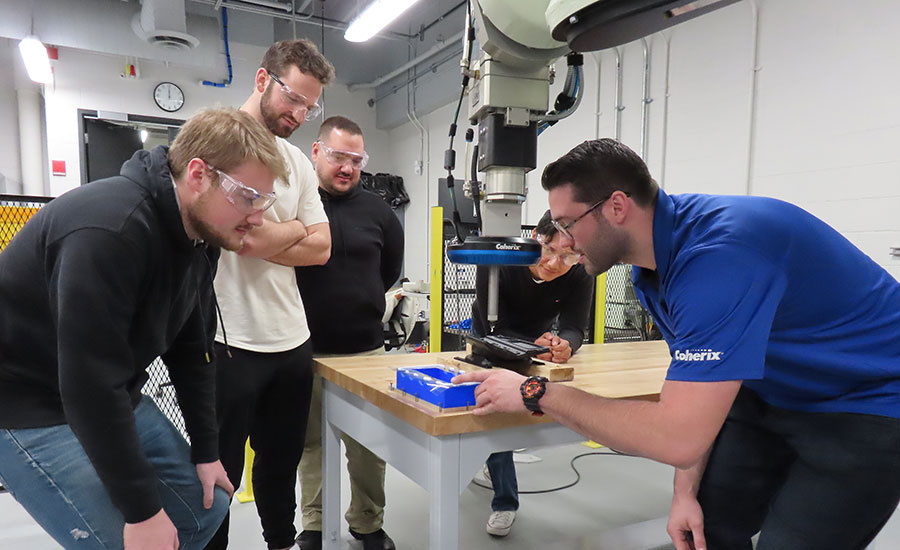Adhesive Dispensing Is Focus of New Program at Eastern Michigan University
By Austin Weber
Article originally appeared in the May 2024 issue of Assembly Magazine

Adhesives are used to assemble a variety of products, including automotive and aerospace parts, appliances, consumer goods, electronics, furniture and medical devices. Among other attributes, adhesive bonding is ideal for joining dissimilar materials, such as glass, metal and plastic.
To improve throughput, boost quality and reduce waste, more manufacturers are using robotic dispensing. However, many engineers and operators lack the knowledge they need to harness the full benefits of the technology.
Eastern Michigan University (EMU) recently launched a program to address the issue. It’s applying state-of-the-art tools to develop the next generation of adhesive engineers by focusing on “factory of the future” manufacturing and assembly technology.
Last fall, Coherix Inc. donated $358,000 to establish the program. The company, which is based nearby in Ann Arbor, MI, provided 3D computer-vision technology to the school. In addition, it lent engineers to EMU to help set up the lab, which includes equipment provided by Kawasaki Robotics; Sames Group, a supplier of sealant and dispensing pumps and equipment; and the Gonzalez Group, a local systems integrator.
The goal of the new three-year program is to expand the use of computer vision, virtual reality and adaptive process control systems in the automotive, electronics and medical industries.
“The program will provide our students with experience in the programming and use of industrial robots to dispense adhesives and sealants in the manufacture of cars, medical devices and consumer electronics—technology that could save billions of dollars in manufacturing costs,” says Mohamad Qatu, Ph.D., P.E., dean of EMU’s GameAbove College of Engineering and Technology.
“We are looking forward to partnering with Eastern Michigan University,” adds Dwight Carlson, chairman and CEO of Coherix. “Our goal is to provide engineering students at the university with advanced factory of the future training, as well as access to the latest dispensing system technology under development at Coherix.
“One thing holding up the factory of the future is that automation cannot see well enough or think fast enough to run autonomously,” says Carlson. “That’s something that we’re trying to solve with 3D computer vision and adaptive process control.
“We also need to accelerate the process of getting young engineers into the factory of the future,” claims Carlson. “Right now, I estimate that there’s a need for around 200 dispensing system engineers just here in Southeastern Michigan.
“Fortunately, other companies feel the same way, so we’ve teamed up to form a nonprofit organization called the Engineering and Manufacturing Alliance,” explains Carlson. “Our mission is to provide research into advanced digital manufacturing methods, while disseminating information regarding research to business and industry.”
EMU’s new program is part of that initiative. Over the next three years, more than 70 graduate and undergraduate students are expected to participate in the curriculum developed and directed by Emad Tanbour, Ph.D., associate professor of mechanical engineering.
“There has been a big increase in demand for using robots to dispense industrial adhesives,” says Tanbour. “3D vision technology enables the dispensing process to be more accurate and precise, while responding to changes in product variation. It also allows for visualization and measurement, enabling the economic analysis of adhesives, which can be very expensive.
“This one-of-a-kind program utilizes virtual reality for both educational and research purposes,” notes Tanbour. “Among other things, students will study the impact of artificial intelligence technology when dispensing adhesives with robotics.”
There are currently 13 undergrad engineers and two graduate students participating in the program, which was launched in September 2023. The facility is housed within part of the 1,500-square-foot Virtual Reality Lab at EMU. In addition to hands-on learning with dispensing robots, virtual reality tools enable students to artificially add complexity to joints or change part designs to examine various what-if scenarios.
Students are divided into three teams that are each working on a different project. One adhesive bonding application involves a scaled-down car door, while the others include an industrial gearbox housing and an electronic medical device. The undergrad students are working with 3D-printed plastic components, but the grad students are examining how adhesives interact with dissimilar materials, such as metals and plastics.
Due to safety requirements, engineers use a make-believe material instead of actual adhesive. It’s a petroleum gel that has all of the viscosity and material properties of an industrial adhesive. This enables students to repeatedly apply the material to their parts and conduct experiments to optimize various assembly processes.
EMU is located in the shadow of larger and more prestigious schools known for their engineering prowess, such as the University of Michigan and Wayne State University. However, Carlson believes those institutions are not necessarily producing the type of engineers desperately needed by manufacturers today. “We need more engineers with a different kind of attitude who are ready to step foot into the factory of the future,” he points out.
“Eventually, I’d like to see more of our peer universities in the region involved in similar programs, so that we can replicate our efforts and expand the footprint,” adds Tanbour.
Article originally appeared in the May 2024 issue of Assembly Magazine
Austin Weber has been senior editor for ASSEMBLY Magazine since September 1999. He has more than 21 years of b-to-b publishing experience and has written about a wide variety of manufacturing and engineering topics. Austin is a graduate of the University of Michigan.